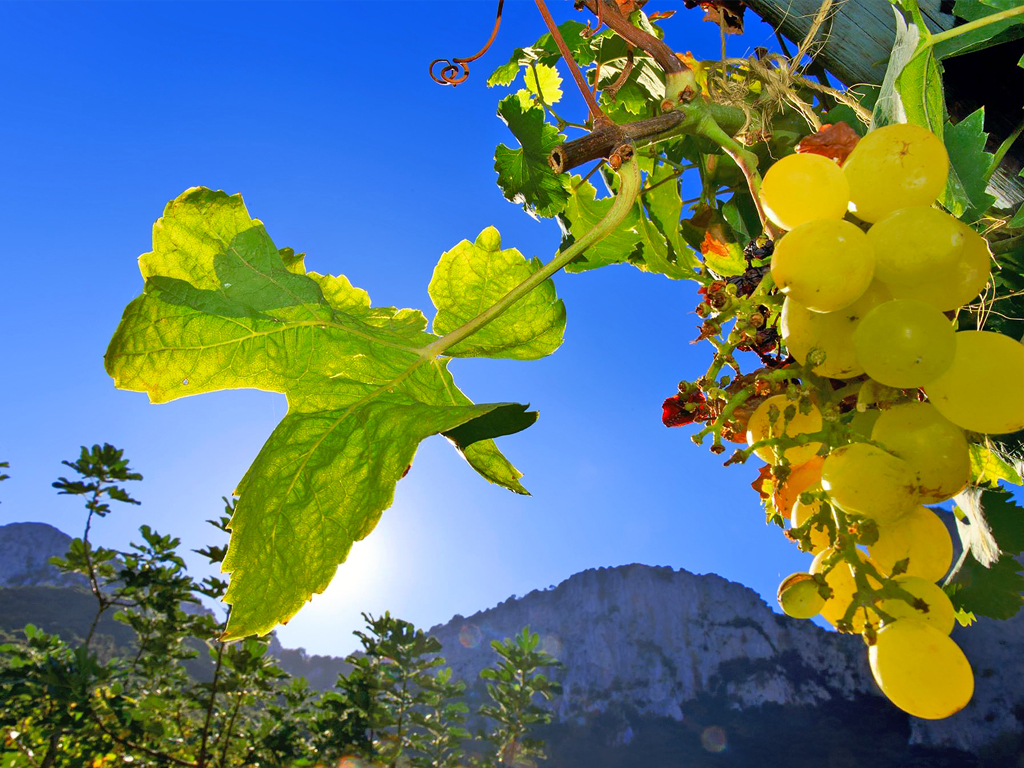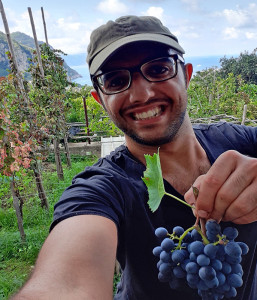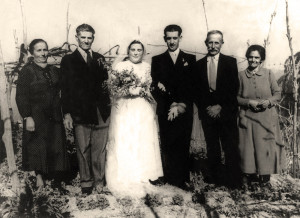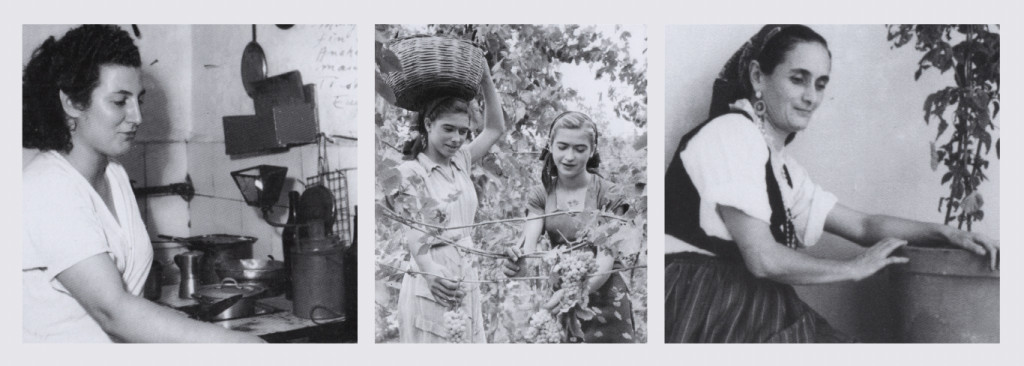
L’isola nel bicchiere
di Silvia Baldassarre
Bianco o rosso che sia, il vino di Capri porta con sé il profumo del mare, l’essenza degli agrumi, la forza della ginestra e la fragranza della macchia mediterranea. Ma coltivare la terra, su quest’isola, non è certo una cosa semplice. Le sue grandi bellezze sono anche le caratteristiche che più rendono difficile il lavoro nei campi. I pendii, la roccia presente nel suolo e spesso la frammentazione degli appezzamenti aggiungono fatica ad un lavoro già di per sé impegnativo. Allo stesso tempo, però, tutto questo influisce sulle proprietà organolettiche del vino e fa dire, già dopo il primo sorso, “questo sì che è un autentico vino di Capri!”.
«Soprattutto la salinità marina – racconta Augusto Federico – unita alla natura del suolo dolomitico-calcareo, contribuiscono a far  assumere, all’uva prima e al vino poi, tutte le caratteristiche del luogo, sia come linfa che come sentori». Augusto è membro di una famiglia isolana che ha come soprannome, nella più classica delle usanze capresi, quello di Verginiello, come il ristorante di via Lo Palazzo. Con una laurea in Giurisprudenza appena conseguita e con il motto “meglio un vignaiolo felice che un avvocato famoso”, a soli 29 anni ha preso in mano l’eredità del nonno viticoltore – di cui porta anche il nome – scomparso centenario nel 2017. Complice l’aria respirata sin da bambino, da semplice amatore del vino e della viticoltura all’idea di un vero e proprio lavoro il passo è stato naturale.
assumere, all’uva prima e al vino poi, tutte le caratteristiche del luogo, sia come linfa che come sentori». Augusto è membro di una famiglia isolana che ha come soprannome, nella più classica delle usanze capresi, quello di Verginiello, come il ristorante di via Lo Palazzo. Con una laurea in Giurisprudenza appena conseguita e con il motto “meglio un vignaiolo felice che un avvocato famoso”, a soli 29 anni ha preso in mano l’eredità del nonno viticoltore – di cui porta anche il nome – scomparso centenario nel 2017. Complice l’aria respirata sin da bambino, da semplice amatore del vino e della viticoltura all’idea di un vero e proprio lavoro il passo è stato naturale.
Ma cosa significa fare il vino a Capri, oggi? Spiega ancora Augusto: «Significa recuperare la cultura e le nostre radici. Sono pochi gli esempi di persone che hanno portato avanti questa tradizione a livello familiare. Fino alla metà del Novecento la viticoltura era sparsa un po’ per tutta l’isola, si pensi che si è passati da una superficie vitata di circa 200 ettari ai quindici attuali».
È vero, oggi ci sono poche realtà vitivinicole a Capri. Tra queste senza dubbio spicca la vinicola Scala Fenicia che si trova non lontano dall’omonima gradinata che collega Capri ad Anacapri e che è ormai una realtà isolana molto conosciuta. E poi c’è don Vincenzo Simeoli che sui terreni di famiglia, insieme a parenti e amici, coltiva la vite e tramanda i segreti delle specie autoctone isolane.
 La famiglia di Augusto, invece, vanta una tradizione di viticoltori già dalla metà dell’Ottocento quando un quadrisavolo impiantò le prime viti in varie zone dell’isola come Unghia Marina, Tragara e Marucella. Dal nonno poi, le cantine sociali e le trattorie erano solite comprare il vino spillato direttamente dalle botti in castagno. «Io ho deciso di riprendere in mano la storia di famiglia. Un sogno sopito che si è risvegliato, una storia che non volevo lasciare inascoltata o che rimanesse nella sola sfera del ricordo».
La famiglia di Augusto, invece, vanta una tradizione di viticoltori già dalla metà dell’Ottocento quando un quadrisavolo impiantò le prime viti in varie zone dell’isola come Unghia Marina, Tragara e Marucella. Dal nonno poi, le cantine sociali e le trattorie erano solite comprare il vino spillato direttamente dalle botti in castagno. «Io ho deciso di riprendere in mano la storia di famiglia. Un sogno sopito che si è risvegliato, una storia che non volevo lasciare inascoltata o che rimanesse nella sola sfera del ricordo».
Non sappiamo ancora il nome dell’etichetta, di certo però Capri avrà a breve una nuova realtà vinicola che ha l’ambizione di produrre poche bottiglie, ma di qualità.
E soprattutto un vino che sia naturale. «Un vino che non prevede interventi di chimica di sintesi sia in vigna come trattamenti, dove si utilizzano solo rame e zolfo, sia in cantina riducendo al minimo l’utilizzo di altre sostanze».
La tradizione di famiglia vuole che sia prodotto soprattutto rosso, realizzato con uve Piedirosso e Tintore. Ciò non toglie che in vigna si trovino anche le uve destinate alla vinificazione in bianco come la Biancolella con la denominazione caprese San Nicola e il Greco, con la denominazione caprese Ciunchese oltre naturalmente a un po’ di Falanghina, tipica della Campania.
«Quello che ci lega a Capri – dice Augusto – è un legame indissolubile con la terra e creare qualcosa significa creare un legame ancora più forte. Attraverso un sorso di vino vorremmo far percepire la bellezza e la verità di questi luoghi perché Capri ha due anime, una più mondana e una più autentica, noi con il nostro lavoro cerchiamo di far conoscere questo aspetto dell’isola un po’ meno conosciuto».
Antichi sapori, moderni piaceri
 Parlare del vino di Capri significa raccontare anche la storia dell’isola. L’uva era già coltivata ai tempi di Tiberio e ancor prima dai coloni greci. Tracce del vino di Capri si ritrovano, naturalmente, anche nel periodo dei D’Angiò e dei Borbone, passando per le varie dominazioni che hanno reso questo luogo crocevia del Mediterraneo dai tempi antichi a quelli più moderni. Ma non si può raccontare la storia del vino di Capri senza considerare il resto della tavola e richiamare alla mente, quindi, gli abbinamenti e le prelibatezze autoctone che hanno contribuito a rendere l’isola un luogo d’elezione anche dal punto di vista culinario.
I prodotti enogastronomici, così, insieme alle bellezze naturali e architettoniche, sono diventati protagonisti di miti e leggende, oltre che della storia stessa.
A raccontarci tutto questo è Giuseppe Aprea, studioso di Capri e della sua storia e Direttore del Centro Documentale dell’Isola. Ecco quindi che nel suo ultimo lavoro, Il libro del vino e del mangiar antico nell’isola di Capri (Edizioni La Conchiglia) l’autore ci prende per mano e ci accompagna in un tour enogastronomico che parte da lontano per andare a scoprire “Cronache, racconti, personaggi e segreti di locande, osterie e di altri Luoghi della Felicità” come recita il sottotitolo del libro.
Si scopre, tra le pagine del volume, una Capri autentica che esprime se stessa nella sua veste più sincera. Una padrona di casa in grado di offrire, oggi come in passato, accoglienza e ospitalità come pochi altri nel mondo, con un occhio di riguardo alla tavola ricca di prelibatezze ognuna delle quali accompagnata da un bicchiere di ottimo vino, rigorosamente di Capri. | Ancient flavours, modern pleasures. Talking about the wine of Capri also means telling the island’s history. Grapes were already being cultivated at the time of
Parlare del vino di Capri significa raccontare anche la storia dell’isola. L’uva era già coltivata ai tempi di Tiberio e ancor prima dai coloni greci. Tracce del vino di Capri si ritrovano, naturalmente, anche nel periodo dei D’Angiò e dei Borbone, passando per le varie dominazioni che hanno reso questo luogo crocevia del Mediterraneo dai tempi antichi a quelli più moderni. Ma non si può raccontare la storia del vino di Capri senza considerare il resto della tavola e richiamare alla mente, quindi, gli abbinamenti e le prelibatezze autoctone che hanno contribuito a rendere l’isola un luogo d’elezione anche dal punto di vista culinario.
I prodotti enogastronomici, così, insieme alle bellezze naturali e architettoniche, sono diventati protagonisti di miti e leggende, oltre che della storia stessa.
A raccontarci tutto questo è Giuseppe Aprea, studioso di Capri e della sua storia e Direttore del Centro Documentale dell’Isola. Ecco quindi che nel suo ultimo lavoro, Il libro del vino e del mangiar antico nell’isola di Capri (Edizioni La Conchiglia) l’autore ci prende per mano e ci accompagna in un tour enogastronomico che parte da lontano per andare a scoprire “Cronache, racconti, personaggi e segreti di locande, osterie e di altri Luoghi della Felicità” come recita il sottotitolo del libro.
Si scopre, tra le pagine del volume, una Capri autentica che esprime se stessa nella sua veste più sincera. Una padrona di casa in grado di offrire, oggi come in passato, accoglienza e ospitalità come pochi altri nel mondo, con un occhio di riguardo alla tavola ricca di prelibatezze ognuna delle quali accompagnata da un bicchiere di ottimo vino, rigorosamente di Capri. | Ancient flavours, modern pleasures. Talking about the wine of Capri also means telling the island’s history. Grapes were already being cultivated at the time of

Lucia Arcucci nella cucina del ristorante Grotta Verde. Anacapri, anni Cinquanta, giovani vendemmiatrici. Giuseppina De Martino del ristorante La Pigna. • Lucia Arcucci in the kitchen of the Grotta Verde restaurant. Anacapri, in the 1950s, young grape harvesters. Giuseppina De Martino from La Pigna restaurant.
Tiberius and even before that, by the Greek colonists. Traces of Capri wine have been found from the time of the Angevin and Bourbon rulers too, of course, and throughout the various dominations that have made this place a crossroads of the Mediterranean from ancient times to more modern eras. But you can’t tell the story of Capri wine without taking into account the food too, and hence calling to mind the combinations and native delicacies that have helped to make the island a favourite place for fine dining as well. Thus, alongside the island’s natural and architectural beauties, food and wine have also played a key role in myths and legends, as well as in the history of the place. Giuseppe Aprea, an expert on Capri and its history and Director of the Island Document Centre tells us all about this. In his latest book, in fact, Il libro del vino e del mangiar antico nell’isola di Capri (The book of wine and food from the past on the island of Capri) (Edizioni La Conchiglia), the author takes us by the hand and accompanies us on a food and wine tour that starts off far back in time, exploring “Reports, stories, people and secrets of the bars, osterias and other Places of Happiness” as stated in the book’s subtitle. In the pages of this book we find an authentic Capri that expresses itself in its most sincere guise. A hostess who offers us, today as in the past, a welcome and hospitality matched by few others around the world, with a special focus on the dining-table laden with delicacies, each accompanied by a glass of excellent wine, from Capri, of course.
The island in a glass
by Silvia Baldassarre
Whether white or red, the wine of Capri brings with it the scent of the sea, the essence of citrus fruits, the vigour of broom, and the fragrance of the Mediterranean scrub. But cultivating the land on this island is no simple matter. The great beauties of the island are those same features that make work in the fields so difficult. The inclines, the rocky soil and often the fragmentation of the plots of land all make the difficult job of working the fields even tougher. But at the same time all of this has an influence on the organoleptic properties of the wine, so that people can say at the first sip: “This is definitely a genuine Capri wine!”
“It is the salinity of the sea above all, together with the dolomitic-calcareous nature of the soil, that help make first the grape and then the wine take on all the characteristics of the place, both in terms of the essential structure and the aromas,” explains Augusto Federico. Augusto is from a Capri family nicknamed, in the most classic of Capri traditions, Verginiello, like the restaurant in Via Lo Palazzo. Having just graduated with a degree in Law, and taking to heart the motto “Better a happy wine-grower than a famous lawyer,” at just 29 years old he took on the legacy of his vine-growing grandfather, who he is named after, and who died in 2017 at the age of a hundred. Aided by the air he had breathed in since he was a child, it was a natural step to go from being simply a lover of wine and wine-making to the idea of making an actual career in the business.
But what does making wine on Capri mean today? Augusto explains: “It means restoring the culture and our roots. Very few people have actively pursued this tradition at the family level. Until the mid-20th century, vine-growing was scattered more or less all over the island: the surface area of land planted with vines has now decreased from about 200 hectares to only fifteen today.”
It is true that there are few wineries on Capri today. One of the foremost is definitely the Scala Fenicia winery, now a well-known island company based not far from the steps of the same name that link Capri with Anacapri. Then there’s Don Vincenzo Simeoli who cultivates vines on his family land together with his relatives and friends, passing on the secrets of the island’s native species.
Augusto’s family, on the other hand, boasts a winemaking tradition that dates back to the mid-19th century when his great-great-great-grandfather planted the first vines in various areas of the island such as Unghia Marina, Tragara and Marucella. The island’s wine cellars and trattorias used to buy his grandfather’s wine drawn directly from the chestnut-wood barrels. “I decided to take the family history in hand, to satisfy a dream that had been reawakened, a history that I didn’t want to leave unheeded or remaining only in the realm of memory.”
We don’t yet know what will be the name on the label, but what’s certain is that Capri will soon have a new wine-making company whose ambition is to produce a small number of bottles, but of fine quality wine. And above all a wine that is natural. “A wine that will not undergo any synthetic chemical processing either as treatments in the vineyard, where we only use copper and sulphur, or in the cellar, keeping the use of other substances to a minimum.”
In accordance with family tradition, they produce mainly red wine, made with Piedirosso and Tintore grapes. However, there are also grapes in the vineyard that are used to make white wine such as Biancolella, with the Capri denomination San Nicola and Greco, with the Capri denomination Ciunchese, as well as a little Falanghina, of course, a typical grape of Campania.
“What binds us to Capri is an indissoluble bond with the land,” says Augusto, “and creating something significant means forging an even stronger bond. We want to make people perceive the beauty and truth of these places through a sip of wine, because Capri has two souls: one that is more worldly, and one that is more authentic, and with our work we try to show people that less well-known aspect of the island.”





